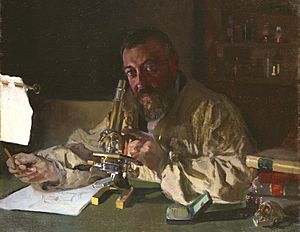Luis Simarro Lacabra facts for kids
Quick facts for kids
Luis Simarro Lacabra
|
|
|---|---|

Portrait of Dr Simarro at the microscope by Joaquín Sorolla, 1897
|
|
| Born | 6 January 1851 |
| Died | 19 June 1921 (aged 70) |
| Nationality | Spanish |
| Education | Complutense University of Madrid University of Valencia |
| Scientific career | |
| Fields | Neurology |
| Institutions | Complutense University of Madrid |
Luis Simarro Lacabra (born January 6, 1851 – died June 19, 1921) was a Spanish doctor. He was a very important neurologist. Neurologists are doctors who study the brain and nerves. Luis Simarro was born in Rome, Italy. His parents were living there at the time.
Contents
Luis Simarro's Life and Work
Early Life and Studies
Luis Simarro studied medicine in Valencia and Madrid. In 1877, he became the director of a special hospital. This hospital was called the Santa Isabel insane asylum. It was located near Madrid, in a town called Leganés.
From 1880, Simarro lived in Paris, France. There, he continued his studies. He learned about general anatomy, which is the study of the body's structure. He also studied histology, which is the study of tiny tissues using a microscope. He learned about clinical neurology too.
A Pioneer in Psychology
In 1885, Luis Simarro returned to Madrid. He opened his own private medical office. In 1902, he made history in Spain. He was given the very first job as a professor of experimental psychology. Experimental psychology uses scientific methods to study how people think and behave. This was a big step for science in Spain.
Improving Science: The Silver Stain
Even with his work in psychology, Simarro is best known for something else. He made a big contribution to histology. Histology is the study of tissues under a microscope.
A scientist named Camillo Golgi had a special way to stain tissues. He used a technique with silver chromate. This stain helped scientists see tiny parts of cells. Simarro improved Golgi's method. He used a different silver chemical called silver bromide.
This new method was very important. A famous Spanish histologist, Ramon y Cajal, praised Simarro's work. Ramon y Cajal said that Simarro's improved stain was a huge help. It allowed him to focus on studying brain tissues in great detail.
See also
 In Spanish: Luis Simarro para niños
In Spanish: Luis Simarro para niños

